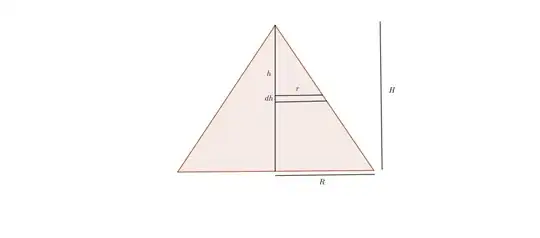I'm trying to derive the expressions for the volume and curved surface area of a cone using integration, but something doesn't feel right to me, and I was hoping for some help with the same. The problem is as follows:
I considered the following section of a cone of height $H$ and radius $R$.
Now, at a height $h$ from the apex of the cone, I considered an infinitesimally small increase in height $dh$. Now, the small increase in volume $dV$ due to the small increase in height $dh$ is given by the volume of the cylinder with height $dh$ and radius r (Note that only half the cylinder is shown in the figure). So,
$dV = \pi{r}^2dh$
Also, due to similarity of triangles, $\frac{r}{h} = \frac{R}{H} \implies r = h\frac{R}{H} \implies r^2 = h^2\frac{R^2}{H^2}$
Now,
$dV = \pi{h^2}\frac{R^2}{H^2}dh$
Integrating from $0$ to $H$, we get
$$V = \int_0^H\pi{h^2}\frac{R^2}{H^2}dh$$ $$V = \pi\frac{R^2}{H^2}\int_0^H{h^2}dh$$ $$V = \frac{\pi R^2H}{3}$$
And this is the correct expression.
The problem is while trying to derive an expression for the curved surface area using the same method. Here, if I consider the small change in area to be the curved surface area of the infinitesimally thin cylinder and integrate from $0$ to $H$, this happens:
$$dA = 2\pi rdh$$ $$A = \int_0^H 2\pi rdh$$ $$A = 2\pi\int_0^H h\frac{R}{H}dh$$ $$A = 2\pi\frac{R}{H}\int_0^Hhdh$$ $$A = \pi RH$$
However, this is the wrong expression and the required area is actually $A = \pi R S$, where $S$ is the slant height of the cone.
Although the cylindrical approximation yields the right volume, it fails while finding the curved surface area. Now, I have found that the same question has been discussed here and here. But all I can gather from these discussions is that considering the cone to be made up of small cylinders is not a good approximation in terms of its surface area, which was already quite obvious from the incorrect expression arrived at.
What I don't quite understand is why the exact same idea gives the correct expression for the volume but not the surface area of the same object.
What is it that makes the error associated with approximating a cone as a stack of cylinders negligible while finding its volume but quite prominent while finding its surface area?
(Thanks in advance!)
